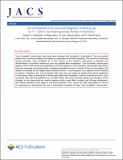| dc.contributor.author | DeGayner, Jordan A. | |
| dc.contributor.author | Jeon, Ie-Rang | |
| dc.contributor.author | Harris, T. David | |
| dc.contributor.author | Sun, Lei | |
| dc.contributor.author | Dinca, Mircea | |
| dc.date.accessioned | 2018-04-03T14:56:02Z | |
| dc.date.available | 2018-04-03T14:56:02Z | |
| dc.date.issued | 2017-03 | |
| dc.date.submitted | 2017-01 | |
| dc.identifier.issn | 0002-7863 | |
| dc.identifier.issn | 1520-5126 | |
| dc.identifier.uri | http://hdl.handle.net/1721.1/114503 | |
| dc.description.abstract | We report the magnetism and conductivity for a redox pair of iron-quinoid metal–organic frameworks (MOFs). The oxidized compound, (Me[subscript 2]NH[subscript 2])2[Fe[subscript 2]L[subscript 3]]·2H[subscript 2]O·6DMF (LH[subscript 2] = 2,5-dichloro-3,6-dihydroxo-1,4-benzoquinone) was previously shown to magnetically order below 80 K in its solvated form, with the ordering temperature decreasing to 26 K upon desolvation. Here, we demonstrate this compound to exhibit electrical conductivity values up to σ = 1.4(7) × 10[superscipt –2] S/cm (Ea = 0.26(1) cm[subscript –1]) and 1.0(3) × 10[subscript –3] S/cm (Ea = 0.19(1) cm[subscript –1]) in its solvated and desolvated forms, respectively. Upon soaking in a DMF solution of Cp[subscript 2]Co, the compound undergoes a single-crystal-to-single-crystal one-electron reduction to give (Cp[subscript 2]Co)[subscript 1.43](Me[subscript 2]NH2)[subscript 1.57][Fe[subscript 2]L[subscript 3]]·4.9DMF. Structural and spectroscopic analysis confirms this reduction to be ligand-based, and as such the trianionic framework is formulated as [Fe[superscript III][subscript 2](L3[superscript –•])[subscript 3]][superscript 3–]. Magnetic measurements for this reduced compound reveal the presence of dominant intralayer metal–organic radical coupling to give a magnetically ordered phase below T[subscript c] = 105 K, one of the highest reported ordering temperatures for a MOF. This high ordering temperature is significantly increased relative to the oxidized compound, and stems from the overall increase in coupling strength afforded by an additional organic radical. In line with the high critical temperature, the new MOF exhibits magnetic hysteresis up to 100 K, as revealed by variable-field measurements. Finally, this compound is electrically conductive, with values up to σ = 5.1(3) × 10[superscript –4] S/cm with Ea = 0.34(1) eV. Taken together, these results demonstrate the unique ability of metal-quinoid MOFs to simultaneously exhibit both high magnetic ordering temperatures and high electrical conductivity. | en_US |
| dc.description.sponsorship | United States. Department of Energy. Office of Basic Energy Sciences (Massachusetts Institute of Technology. Energy Frontier Research Center for Excitonics. Award DE-SC0001088) | en_US |
| dc.description.sponsorship | Alfred P. Sloan Foundation | en_US |
| dc.description.sponsorship | Research Corporation for Science Advancement | en_US |
| dc.description.sponsorship | Camille & Henry Dreyfus Foundation | en_US |
| dc.language.iso | en_US | |
| dc.publisher | American Chemical Society (ACS) | en_US |
| dc.relation.isversionof | http://dx.doi.org/10.1021/jacs.7b00705 | en_US |
| dc.rights | Article is made available in accordance with the publisher's policy and may be subject to US copyright law. Please refer to the publisher's site for terms of use. | en_US |
| dc.source | Prof. Dinca via Erja Kajosalo | en_US |
| dc.title | 2D Conductive Iron-Quinoid Magnets Ordering up to T[subscript c] = 105 K via Heterogenous Redox Chemistry | en_US |
| dc.type | Article | en_US |
| dc.identifier.citation | DeGayner, Jordan A., et al. “2D Conductive Iron-Quinoid Magnets Ordering up to T[subscript c] = 105 K via Heterogenous Redox Chemistry.” Journal of the American Chemical Society, vol. 139, no. 11, Mar. 2017, pp. 4175–84. © 2017 American Chemical Society | en_US |
| dc.contributor.department | Massachusetts Institute of Technology. Department of Chemistry | en_US |
| dc.contributor.approver | Dinca, Mircea | en_US |
| dc.contributor.mitauthor | Sun, Lei | |
| dc.contributor.mitauthor | Dinca, Mircea | |
| dc.relation.journal | Journal of the American Chemical Society | en_US |
| dc.eprint.version | Author's final manuscript | en_US |
| dc.type.uri | http://purl.org/eprint/type/JournalArticle | en_US |
| eprint.status | http://purl.org/eprint/status/PeerReviewed | en_US |
| dspace.orderedauthors | DeGayner, Jordan A.; Jeon, Ie-Rang; Sun, Lei; Dincă, Mircea; Harris, T. David | en_US |
| dspace.embargo.terms | N | en_US |
| dc.identifier.orcid | https://orcid.org/0000-0002-1262-1264 | |
| mit.license | PUBLISHER_POLICY | en_US |
